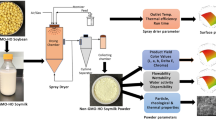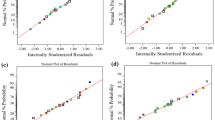Abstract
Blends of defatted soy flour and sweet potato flour were extruded in asingle-screw extruder run at varying pre-set rotational speeds. Diediameter of the extruder was also varied. A central composite, rotatablenearly orthogonal response surface design was used in studying theinteractive effects of extrusion variables on color of the extrudates.Color of raw and processed samples was determined on a DRLANGE TricolorLFM3 instrument. Measurements were made in duplicates to obtain the CIELABL* a* b* values. Results showed that whiteness (L*)decreased with increase in sweet potato in the blends during extrusion.Reduction in whiteness (darkening) evidenced in decreased L* valuesof samples was only affected by increase in sweet potatoes in the blends.Redness (*) significantly increased as sweet potatoes contentincreased, which confirmed the decrease in whiteness. Yellowness(*) also increased considerably, but as a result of the diediameter.
Similar content being viewed by others
References
Colonna P, Tayeb J, Mercier C (1989) Extrusion cooking of starch and starchy products. In Mercier C, Linko P, Harper JM (eds), Extrusion Cooking, St Paul, MN: American Association of Cereal Chemists Inc., pp 247–319.
Wolfe JA (1992) Sweet potato: An Untapped Food Resource. Cambridge, UK: Cambridge Univ. Press.
Berset C (1989) Color. In Mercier C, Linko P, Harper JM (eds), Extrusion Cooking. St. Paul, MN: American Association of Cereal Chemists Inc., pp 399–434.
Noguchi A, Chefel J-C (1983) Extrusion-cooking of protein enriched cookies. Nippon Shokuhin Kogyo Gakkai Shi 30(2): 114–124.
Maga JA, Cohen MR (1978) Effect of extrusion parameters on certain sensory, physical, and nutritional properties of potato flakes. Lebensm Wiss Technol 11: 195–197.
Bjorck I, Asp N-G (1983) The effects of extrusion cooking on nutritional value - A literature review. J Food Eng 2: 281–308.
Petriella C, Resnik SL, Lozano RD, Chirife J (1985) Kinetics of deteriorative reactions in model food systems of high water activity: color changes due to Nonenzymatic browning. J Food Sci 50: 622–626.
Pagliarini E, Vernile M, Peri C (1990) Kinetic study on color changes in milk due to heat. J Food Sci 55(6): 1766–1767.
Sgaramella S, Ames JM (1993) The development of color in extrusion cooked foods. Food Chem 46: 129–132.
Cerruti P, Resnik AS, Fontan CF (1985) Kinetics of deteriorative reactions in model food systems of high water activity: Glucose loss, 5-hydroxymethylfufural accumulation and fluorescence development due to nonenzymatic browning. J Food Sci 50: 627–656.
Mabon TJ (1993) Color measurement of food. Cereal Foods World 38(1): 21–25.
Giese JG (1995) Measuring physical properties of foods. Food Technol: 54–63.
Gullet EA (1992) Color and food. In Hui YH (ed) Encyclopedia of Food Science and Technology. New York: John Wiley & Sons, Inc., pp 452–457.
Andersson RA, Conway HF, Pfeifer VF, Grifin EL (1969a) Gelatinization of corn grits by roll and extrusion cooking. Cereal Sci Today 14(1): 4–7, 11-12.
Andersson RA, Conway HF, Pfeifer VF, Griffin LEJ (1969b) Roll and extrusion cooking of grain sorghum grits. Cereal Sci Today 14: 372–376, 381.
Andersson RA, Conway HF, Peplinski AJ (1970) Gelatinization of corn grits by roll cooking, extrusion cooking and steaming. Staerke 22: 130–134.
Conway HF (1971) Extrusion cooking of cereals and soybeans. Food Prod Dev 5: 14–17, 27-29.
Iwe MO (1997) Optimization of engineering, functional and nutritional properties of single-screw extruded soy-sweet potato blends for food use by Response Surface Methodology. PhD Thesis, University of Nigeria, Nsukka, Nigeria.
Rasch D, Nurnberg G, Williams E (1993) CADEMO Manual, Biorat GmbH Rostock.
Iwe MO, Wolters I, Gort G, Stolp W, van Zuilichem DJ (1998) Behavior of gelatinization and viscosity in soy-sweet potato mixtures by single screw extrusion: A response surface analysis. J Food Engin 38: 369–379.
SAS (1989) RSREG procedure. SAS/STAT User's Guide Version 6, 4th edition, Vol. 2. Cary, NC: SAS Institute Inc. SAS Circle, 1457–1478.
Bouwkamp JC (1985) Processing of sweet potatoes - Canning, freezing, dehydrating. In Bouwkamp JC (ed) Sweet Potato Products: A Natural Eesource for the Tropics. Boca Raton, FL: CRC Press, Inc., pp 185–203.
Kays SJ (1985) Formulated sweet potato products. In Bouwkamp JC (ed) Sweet Potato Products: A Natural Resource for the Tropics. Boca Raton, FL: CRC Press, Inc., pp 205–218.
Author information
Authors and Affiliations
Rights and permissions
About this article
Cite this article
Iwe, M., van Zuilichem, D. & Ngoddy, P. Color of single-screw extruded blends of soy-sweet potato flour – A response surface analysis. Plant Foods Hum Nutr 55, 159–168 (2000). https://doi.org/10.1023/A:1008177304234
Issue Date:
DOI: https://doi.org/10.1023/A:1008177304234




